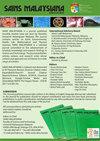羟基磷灰石支撑的 CuO/TiO2 催化甘油的光转化
IF 0.8
4区 综合性期刊
Q3 MULTIDISCIPLINARY SCIENCES
引用次数: 0
摘要
废弃牛骨可用作生产羟基磷灰石(HAp)的原料,而羟基磷灰石是一种良好的有机吸附剂,可用作金属氧化物光催化剂的支撑材料。在这项研究中,牛骨在 900 °C 煅烧 2 小时后制备出了 HAp 粉末,并将其用作含有 CuO 的 TiO2 光催化剂的支撑材料。利用傅立叶变换红外光谱(FTIR)、X 射线衍射(XRD)和扫描电子显微镜(SEM)对六方 HAp 颗粒进行了表征。通过傅立叶变换红外光谱、X 射线衍射、BET 表面积分析、扫描电镜和透射电子显微镜对合成的 HAp 和催化剂进行了表征。在氮气环境下,使用 100 mL 0.5 M 甘油溶液,在 20 W 汞紫外光灯的低光照强度下照射 7 小时,在室温下对甘油进行光催化,测试合成催化剂的光催化性能。在此条件下,CuO/TiO2/HAp 催化剂催化甘油光转化产生的最大氢气产量为 513.7 mmol gcat-1,且未检测到二氧化碳。本文章由计算机程序翻译,如有差异,请以英文原文为准。
Photoreforming of Glycerol Catalyzed by CuO/TiO2 Supported on Hydroxyapatite
Waste bovine bones can be used as a source to produce hydroxyapatite (HAp), which is a good organic adsorbent and used as a support material for metal oxide photocatalysts. In this work, HAp powders were prepared from calcination of bovine bones at 900 °C for 2 h and used as supporting material for a TiO2 photocatalyst incorporating CuO. The hexagonal HAp particles were characterized using Fourier transformed infrared spectroscopy (FTIR), X-ray diffraction (XRD), and scanning electron microscopy (SEM). The 50 wt% TiO2 and 1 wt% CuO/TiO2 supported on HAp photocatalysts were synthesized by the co-precipitation method and finally calcined at 450 °C for 4 h. The synthesized HAp and catalysts were characterized by FTIR, XRD, BET surface area analysis, SEM, and transmission electron microscopy (TEM). The photocatalytic performance of the synthesized catalysts was performed by photoreforming of glycerol at room temperature using 100 mL of 0.5 M glycerol solution under nitrogen atmosphere, irradiating with low-light intensity 20 W Mercury UV lamp for 7 h. The gaseous products catalyzed by the synthesized catalysts were analyzed using a gas chromatograph. The maximum hydrogen gas production from photoreforming of glycerol at this condition was obtained at 513.7 mmol gcat–1 without carbon dioxide detection after catalyzing by CuO/TiO2/HAp catalyst.
求助全文
通过发布文献求助,成功后即可免费获取论文全文。
去求助
来源期刊

Sains Malaysiana
MULTIDISCIPLINARY SCIENCES-
CiteScore
1.60
自引率
12.50%
发文量
196
审稿时长
3-6 weeks
期刊介绍:
Sains Malaysiana is a refereed journal committed to the advancement of scholarly knowledge and research findings of the several branches of science and technology. It contains articles on Earth Sciences, Health Sciences, Life Sciences, Mathematical Sciences and Physical Sciences. The journal publishes articles, reviews, and research notes whose content and approach are of interest to a wide range of scholars. Sains Malaysiana is published by the UKM Press an its autonomous Editorial Board are drawn from the Faculty of Science and Technology, Universiti Kebangsaan Malaysia. In addition, distinguished scholars from local and foreign universities are appointed to serve as advisory board members and referees.
 求助内容:
求助内容: 应助结果提醒方式:
应助结果提醒方式:


